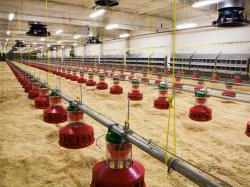Poultry Groups Urge Media Not To Stigmatize Production Methods
July 17, 2012 | 2 min to read

Tucker, GA – In a letter to the editor of Men’s Journal, U.S. Poultry & Egg Association and the National Chicken Council this week wrote to share viewpoints about the magazine’s reporting in its July 2012 edition about its preference for organic over conventionally raised chicken, that alluded to a recent feather meal study and claims of nutritional superiority.
John Glisson, DVM, MAM, Ph.D., director of research programs at the U.S. Poultry & Egg Association and Ashley Peterson, Ph.D., vice president of science and technology at the National Chicken Council, offered a scientific perspective on the claims that certain chemical and antimicrobial residues were found in chicken “feather meal,” and thus are fed to chickens.
For instance, the study in question used a small sample size from 4 lb. and 22 lb. bags of feather meal. “The U.S. poultry industry does not use 4 lb. and 22 lb. bags of feather meal in its commercial feed formulations, and industry experts speculate that the material in these bags were intended to be used as organic fertilizer and not as a source of feed,” Glisson and Peterson wrote. “Furthermore, the study failed to address other potential delivery mechanisms for these types of substances, such as potable water.”
The letter seeks to remind Men’s Journal readers that all chicken produced in the United States is inspected by the USDA, and inspectors test chicken meat samples for chemical and antimicrobial residues so that all poultry is in compliance with USDA standards before it is allowed to enter the marketplace.
“We know consumers have many choices when it comes to their chicken meat purchases,” the letter continued. “However, we do not believe it serves consumers to stigmatize certain production systems to boost others.
“The amazing variety of chicken products today allows consumers to choose products that take into account many factors, including taste preference, personal values and affordability. Your readers should know, however, that USDA says the ‘organic’ label does not indicate that the product has safety, quality or nutritional attributes that are any higher than traditionally raised products.
“All chicken production systems, including organic, natural, and conventional methods, address issues as necessary to achieve its primary objective – the commitment to provide consumers with safe, wholesome and affordable food. The chicken industry works diligently to ensure that no matter which production system they choose to support with their food dollars, consumers can have confidence in the safety and nutrition of all of their chicken purchases,” concluded the letter.
The letter can be viewed by copying and pasting the following link into your web browser. http://www.uspoultry.org/pwire/files/MensJournal_USPOULTRY_NCC_LettertoEditor.pdf
About U.S. Poultry & Egg Association
U.S. Poultry & Egg Association is an all-feather organization representing the complete spectrum of today’s poultry industry, with a focus on progressively serving member companies through research, education, communication, and technical assistance. Founded in 1947, U.S. Poultry & Egg Association is based in Tucker, GA.
About the National Chicken Council
The National Chicken Council represents integrated chicken producer-processors, the companies that produce and process chickens. Member companies of NCC account for more than 95 percent of the chicken sold in the United States.
Source: U.S. Poultry & Egg Association & The National Chicken Council
